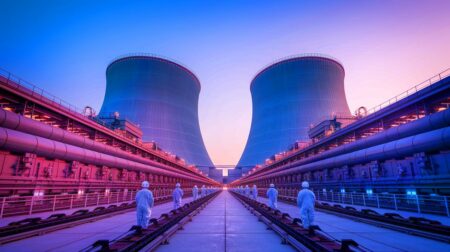Dam Nai in Vietnam is known for its seemingly endless vistas of rice paddies where men and women in conical bamboo hats tend to their crops in picturesque settings. Yet the area in Ninh Thuan province is now known for another thing: Vietnam’s latest and largest wind farm.
Siemens Gamesa has just completed the installation of more than a dozen modern turbines in the midst of rice paddies in the windswept location. Commissioned by a Singaporean energy company called The Blue Circle, the area’s wind farm could soon be producing 90MW of electricity.
At present, Vietnam boasts around 269MW of installed wind capacity, and the communist nation is planning to have 800MW installed by 2020, 2GW by 2025 and 6GW by 2030. Wind and solar power are expected to account for more than 2% and more than 3% of total electricity generation, respectively, although solar energy generation remains in its infancy in Vietnam.
Renewable energy generation in the country is dominated by hydroelectricity, which in 2016 supplied nearly 40% of the country’s electricity. Yet thanks to its 1,650kms of shoreline, much of this elongated Southeast Asian nation is ideally suited for wind energy generation.
In recent years Vietnam has come a long way in boosting its economy and lifting millions out of dire poverty. Almost all local citizens now have ready access to electricity. On the downside, much of that electricity continues to be generated by gas- and coal-fired plants, which has come with considerable costs to human health and the natural environment.
According to industry analysts, Vietnam has great potential for renewables, but the political will to fully embrace them remains rather wanting. “[D]ue to the national electricity companies’ preference for continued investment in well-known technologies and its reluctance to invest in renewables and a business-as-usual emphasis on entrenched technologies such as coal, large hydropower and nuclear energy, very little of this potential has been exploited,” explains an industry journal.
Utility provision remains a state-owned monopoly and “political will is required for a change in policy toward a sustainable business model based on a much larger share of generation from renewable energy sources,” it adds. “To avoid the path of locking the country in a fossil fuel structure, with an increasing stranded assets as well as higher energy dependency, political will is needed.”
Some local entrepreneurs and environmental advocates are hoping to gain wider ground for renewables. “Constructing new coal-fired power stations today locks us into three decades or more of high-cost pollution. We can avoid this by putting an immediate halt to these plans,” says Tran Dinh Sinh, deputy director of GreenID, a local nonprofit dedicated to green causes.
“Vietnam has a major opportunity to stop relying on foreign coal and build our own modern renewable energy system which does not pollute our air, our waterways, and our agricultural land,” he added. “We should make sure we do not miss this chance.”
Did you like it? 4.6/5 (30)








